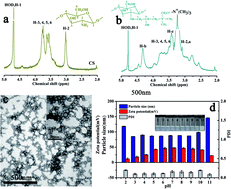Fabrication of zein/quaternized chitosan nanoparticles for the encapsulation and protection of curcumin
Abstract
In this article, we report the successful assembly of nanoparticles (NPs) from a water-soluble chitosan (CS) derivative (N-(2-hydroxyl)propyl-3-trimethyl ammonium chitosan chloride, HTCC) and zein via a low-energy phase separation method. The fabricated NPs were investigated for the first time to encapsulate and protect curcumin (Cur). The particle size and zeta potential of the zein–HTCC NPs varied from 66 to 170 nm and +36.3 to +62.5 mV, respectively. The encapsulation efficiency (EE) was greatly improved to 94.9% after HTCC coating, compared with 85.2% that using zein as a single encapsulant. The microstructure of the NPs was revealed by transmission electron microscopy (TEM). The physicochemical and structural analysis showed that the electrostatic interactions and hydrogen bonds were the major forces responsible for the formation of NPs. The encapsulation forms were evaluated for their efficiency in overcoming Cur's heat and UV sensitivity, which improve the stability about 2.7 fold, 3.5 fold and 2.5 fold when disposed with 60 °C treatment for 30 min, 80 °C treatment for 1 min and ultraviolet radiation for 2 h, respectively at zein–HTCC1 = 1 : 1. The results of the stability and DPPH assays indicated that the bioactivity was being protected upon encapsulation. Zein–HTCC NPs are believed to be promising delivery systems for the supplementation or treatment of hydrophobic nutrients or drugs.


 Please wait while we load your content...
Please wait while we load your content...